Encyclopedia of Southern Jewish Communities - Richmond, Virginia
Richmond: Historical Overview
|
Though Virginia was the oldest of Britain’s North American colonies, its eventual capital city, Richmond, was not founded until 1737. During the Revolutionary War in 1779, Virginia moved its seat of government from Williamsburg to the small town on the James River to protect it from British attack. After independence, Richmond developed as both the political and economic center for Virginia.
Jews have been part of Richmond's history since the colonial era, and Richmond is home to a strong Jewish community today. |
RESOURCES
Weinstein JCC List of Synagogues and Agencies Unless otherwise noted, all photos courtesy of the Beth Ahabah Museum and Archives |
Stories of the Jewish Community in Richmond
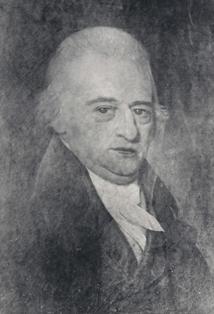 Jacob Cohen
Jacob Cohen
Early Settlers
Colonial Jews were relatively late in settling in Virginia and Richmond. The colony’s lack of a major port city kept most Jews away from the Old Dominion in addition to the established Anglican Church which all residents were required to support. The Virginia Act for Establishing Religious Freedom, passed in 1786, guaranteed the religious rights of Jews and helped open the state to increased Jewish settlement. Probably the first Jew to live in Richmond was Isaiah Isaacs, who first appears in the city’s historical record in 1769. Later, he owned several businesses with his partner, Jacob Cohen. In 1785, they referred to their mercantile store, known as Cohen and Isaacs, as “the Jews store” in a newspaper advertisement. They also owned “The Bird in Hand,” one of Richmond’s earliest tavern and inns. The partners used their profits to purchase a large amount of land in the western territory, even hiring Daniel Boone to help survey it. Cohen and Isaacs dissolved their partnership amicably in 1792. Neither remained in Richmond; Isaacs moved to Charlottesville in 1800 while Cohen settled in Philadelphia in
Although their time in the city was temporary, Isaacs and Cohen set the patterns that would shape Richmond’s Jewish history for the next two centuries. They both became actively involved in civic life and local culture. Isaacs was elected to the Richmond Town Council in 1788; Cohen would serve on it as well seven years later.
As was the case with most white Richmonders of means, Isaacs and Cohen owned slaves as house servants, though both freed them in their wills. Despite embracing this cultural practice of their adopted home, they also had a strong Jewish identity. Indeed, many of their business records, including the dissolution of their partnership, were kept in Yiddish. Isaacs would sign his name in Hebrew on land deeds and other legal documents. Before Richmond had a congregation of its own, Isaacs supported Mickveh Israel in Philadelphia. Both Isaacs and Cohen helped to found Richmond’s first Jewish congregation in 1789.
Colonial Jews were relatively late in settling in Virginia and Richmond. The colony’s lack of a major port city kept most Jews away from the Old Dominion in addition to the established Anglican Church which all residents were required to support. The Virginia Act for Establishing Religious Freedom, passed in 1786, guaranteed the religious rights of Jews and helped open the state to increased Jewish settlement. Probably the first Jew to live in Richmond was Isaiah Isaacs, who first appears in the city’s historical record in 1769. Later, he owned several businesses with his partner, Jacob Cohen. In 1785, they referred to their mercantile store, known as Cohen and Isaacs, as “the Jews store” in a newspaper advertisement. They also owned “The Bird in Hand,” one of Richmond’s earliest tavern and inns. The partners used their profits to purchase a large amount of land in the western territory, even hiring Daniel Boone to help survey it. Cohen and Isaacs dissolved their partnership amicably in 1792. Neither remained in Richmond; Isaacs moved to Charlottesville in 1800 while Cohen settled in Philadelphia in
Although their time in the city was temporary, Isaacs and Cohen set the patterns that would shape Richmond’s Jewish history for the next two centuries. They both became actively involved in civic life and local culture. Isaacs was elected to the Richmond Town Council in 1788; Cohen would serve on it as well seven years later.
As was the case with most white Richmonders of means, Isaacs and Cohen owned slaves as house servants, though both freed them in their wills. Despite embracing this cultural practice of their adopted home, they also had a strong Jewish identity. Indeed, many of their business records, including the dissolution of their partnership, were kept in Yiddish. Isaacs would sign his name in Hebrew on land deeds and other legal documents. Before Richmond had a congregation of its own, Isaacs supported Mickveh Israel in Philadelphia. Both Isaacs and Cohen helped to found Richmond’s first Jewish congregation in 1789.
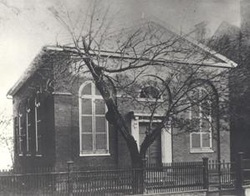 Beth Shalome - Virginia's first synagogue
Beth Shalome - Virginia's first synagogue
Isaacs and Cohen were soon joined by other Jews, most of whom were immigrants from the German states. According to the 1790 census, about 100 Jews lived in Richmond at the time, making up over 4% of the city’s white population. When Richmond Jews established Kahal Kadosh Beth Shalome (Holy Community of the House of Peace) in August, 1789, they were the sixth congregation and the fourth largest Jewish community in the United States. In its founding constitution Beth Shalome limited membership to “free men,” preventing slaves from joining. The congregation initially met in a room in a building on Nineteenth Street. Isaiah Issacs donated land to the congregation in 1791 to be used as a cemetery. Although most Beth Shalome members were Ashkenazic Jews, the congregation adopted the Portuguese Sephardic rite, as was common for Jews in America at the time. Isaac Judah, a local merchant, led services for the fledgling group during its early years. After moving to a larger building, Beth Shalome bought land for a permanent synagogue in 1818. Four years later, they dedicated Virginia’s first synagogue in a big public ceremony that drew lots of non-Jews. Jacob Mordecai, the only remaining founder of the congregation, gave the keynote address.
Indeed, there was a lot of turnover in the Richmond Jewish community in this early period as Jews came and went, often residing in Richmond for a only a few years before moving to other American cities. Isaac Leeser came to Richmond in 1824 at age 18. He soon gained notice after publishing articles about Judaism in the local newspaper and engaging in a written theological debate with a Christian minister. In 1828, he was hired by Mickveh Israel in Philadelphia as their spiritual leader. Leeser would go on to become the country’s foremost spokesman for traditional Judaism. By 1820, about 200 Jews lived in Richmond, most of whom were merchants and auctioneers, though there were a few lawyers and physicians.
Indeed, there was a lot of turnover in the Richmond Jewish community in this early period as Jews came and went, often residing in Richmond for a only a few years before moving to other American cities. Isaac Leeser came to Richmond in 1824 at age 18. He soon gained notice after publishing articles about Judaism in the local newspaper and engaging in a written theological debate with a Christian minister. In 1828, he was hired by Mickveh Israel in Philadelphia as their spiritual leader. Leeser would go on to become the country’s foremost spokesman for traditional Judaism. By 1820, about 200 Jews lived in Richmond, most of whom were merchants and auctioneers, though there were a few lawyers and physicians.
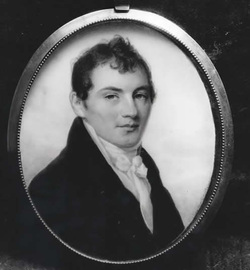 Joseph Marx
Joseph Marx
Organized Jewish Life in Richmond
By 1841, Beth Shalome had 100 members. That same year, the Beth Shalome Ladies Auxiliary founded a religious school, led by Emma Mordecai. In 1847, they began to hold public balls to raise money for the school. Covered in depth by the local newspapers, these parties often attracted more Gentile than Jewish attendees and lasted almost until 4 am. In 1849, Virginia’s governor and speaker of the assembly attended the grand event. Despite this community support, Beth Shalome sometimes struggled financially. In 1848, they published a notice in Isaac Leeser’s Occident newspaper calling for a chazzan “whose expectations of salary are not very extravagant.” In 1849, Beth Shalome hired its first ordained rabbi, Julius Eckman, who also ran the Hebrew and English Academy, a Jewish day school that taught both religious and secular subjects. Eckman left after only two years to serve Beth Elohim in Charleston.
By the 1830s, a growing number of new immigrants from the German states, especially Bavaria, began to arrive in Richmond. They initially joined Beth Shalome, the city’s only Jewish congregation, but in 1839 they established their own social and charitable organization “Chebrah Ahabat Israel” (Association for the Love of Israel). Two years later, around 20 of these German immigrants, wishing to follow the Ashkenazic rather than the Sephardic rite, broke off from Beth Shalome and transformed Chebrah Ahabat Israel into a formal congregation named Beth Ahabah (House of Love). The traditional congregation rented a house on Marshall Street, dedicating it as a synagogue on May 15, 1841. In 1846 they hired Max Michelbacher as their spiritual leader. By 1847, Beth Ahabah had 36 members and soon purchased land for a synagogue. They published a fundraising appeal in the Occident in 1847 and received $800 in donations from local Christians. In 1848, they dedicated their new synagogue during a period of tremendous growth. By 1851, Beth Ahabah had about 80 members. In addition to leading the congregation, Michelbacher also ran a day school that taught Judaism, German, and secular subjects. Beth Ahabah’s school remained in operation for 20 years before disbanding after public schools were established in Richmond in 1871.
In addition to Beth Ahabah, the city’s growing number of German Jews created several other Jewish organizations. In 1849, Reverend Michelbacher helped to establish the Ladies Hebrew Association, which raised money to help those in need. It later became the Ladies Hebrew Benevolent Association. During the 1850s, German Jews founded the Hebrew Young Men’s Literary Association and the Old Dominion Debating Society. They also created the Shebeth Achim Benevolent Society which offered sickness and death benefits to its members. When it disbanded in 1865, its remaining members established Richmond’s first B’nai B’rith Lodge.
Jewish immigrants from Posen established their own Polish-style congregation in 1856. Named Keneseth Israel (Gathering of Israel), the congregation had 32 members by 1859. The small Orthodox congregation did not acquire a synagogue until after the Civil War. In 1868, they bought property on Mayo Street, dedicating their synagogue in 1869. According to newspaper accounts, about 300 people attended the event including “not a few Gentiles, who manifested much interest in the exercises.” On the eve of the Civil War, Richmond had three different Jewish congregations. Although all of them were Orthodox in practice, they each served a different segment of the Jewish community. Beth Shalome was home to the dwindling number of native-born descendants of the Jewish community’s founding families, Beth Ahabah attracted German Jews, while newly arriving Polish immigrants worshiped at Keneseth Israel.
By 1841, Beth Shalome had 100 members. That same year, the Beth Shalome Ladies Auxiliary founded a religious school, led by Emma Mordecai. In 1847, they began to hold public balls to raise money for the school. Covered in depth by the local newspapers, these parties often attracted more Gentile than Jewish attendees and lasted almost until 4 am. In 1849, Virginia’s governor and speaker of the assembly attended the grand event. Despite this community support, Beth Shalome sometimes struggled financially. In 1848, they published a notice in Isaac Leeser’s Occident newspaper calling for a chazzan “whose expectations of salary are not very extravagant.” In 1849, Beth Shalome hired its first ordained rabbi, Julius Eckman, who also ran the Hebrew and English Academy, a Jewish day school that taught both religious and secular subjects. Eckman left after only two years to serve Beth Elohim in Charleston.
By the 1830s, a growing number of new immigrants from the German states, especially Bavaria, began to arrive in Richmond. They initially joined Beth Shalome, the city’s only Jewish congregation, but in 1839 they established their own social and charitable organization “Chebrah Ahabat Israel” (Association for the Love of Israel). Two years later, around 20 of these German immigrants, wishing to follow the Ashkenazic rather than the Sephardic rite, broke off from Beth Shalome and transformed Chebrah Ahabat Israel into a formal congregation named Beth Ahabah (House of Love). The traditional congregation rented a house on Marshall Street, dedicating it as a synagogue on May 15, 1841. In 1846 they hired Max Michelbacher as their spiritual leader. By 1847, Beth Ahabah had 36 members and soon purchased land for a synagogue. They published a fundraising appeal in the Occident in 1847 and received $800 in donations from local Christians. In 1848, they dedicated their new synagogue during a period of tremendous growth. By 1851, Beth Ahabah had about 80 members. In addition to leading the congregation, Michelbacher also ran a day school that taught Judaism, German, and secular subjects. Beth Ahabah’s school remained in operation for 20 years before disbanding after public schools were established in Richmond in 1871.
In addition to Beth Ahabah, the city’s growing number of German Jews created several other Jewish organizations. In 1849, Reverend Michelbacher helped to establish the Ladies Hebrew Association, which raised money to help those in need. It later became the Ladies Hebrew Benevolent Association. During the 1850s, German Jews founded the Hebrew Young Men’s Literary Association and the Old Dominion Debating Society. They also created the Shebeth Achim Benevolent Society which offered sickness and death benefits to its members. When it disbanded in 1865, its remaining members established Richmond’s first B’nai B’rith Lodge.
Jewish immigrants from Posen established their own Polish-style congregation in 1856. Named Keneseth Israel (Gathering of Israel), the congregation had 32 members by 1859. The small Orthodox congregation did not acquire a synagogue until after the Civil War. In 1868, they bought property on Mayo Street, dedicating their synagogue in 1869. According to newspaper accounts, about 300 people attended the event including “not a few Gentiles, who manifested much interest in the exercises.” On the eve of the Civil War, Richmond had three different Jewish congregations. Although all of them were Orthodox in practice, they each served a different segment of the Jewish community. Beth Shalome was home to the dwindling number of native-born descendants of the Jewish community’s founding families, Beth Ahabah attracted German Jews, while newly arriving Polish immigrants worshiped at Keneseth Israel.
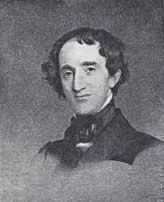 Gustavus Myers
Gustavus Myers
Jewish Businesses in Richmond
Regardless of their ethnic background, most Richmond Jews were concentrated in retail trade during the antebellum era. In 1845, 25% of the city’s retail merchants were Jews. By 1855, over 100 Jewish merchants were listed in the city directory. One of these was William Thalhimer, who had opened a small dry goods store in 1842. The business grew over the years, settling into a big, five-story building in downtown Richmond. Thalhimer’s later became a regional chain of department stores, with locations throughout Virginia and North Carolina.
Many of Richmond’s Jewish merchants balked when the city council passed a new Sunday closing law in 1845, fining store owners who did business on the Christian Sabbath. After several Jewish-owned businesses were fined, they petitioned the city council declaring the law to be unconstitutional and unfair since they already closed their stores on Saturday, the Jewish Sabbath. This law, they argued, would “injure them in the pursuit of happiness, which is the natural and inalienable right of every man.” After continual appeals, the ordinance, whose original purpose was to prevent large numbers of slaves congregating downtown on their day off, was repealed. In 1849, the state amended its closing law to exempt those who observed the Sabbath on Saturdays. When President Tyler called Americans “a Christian people” in 1841, Jacob Ezekial, an officer of Beth Shalome, wrote a letter of protest. By the 1840s, Richmond Jews were comfortable asserting their rights and using the ideology and language of the American Revolution to make their case.
Regardless of their ethnic background, most Richmond Jews were concentrated in retail trade during the antebellum era. In 1845, 25% of the city’s retail merchants were Jews. By 1855, over 100 Jewish merchants were listed in the city directory. One of these was William Thalhimer, who had opened a small dry goods store in 1842. The business grew over the years, settling into a big, five-story building in downtown Richmond. Thalhimer’s later became a regional chain of department stores, with locations throughout Virginia and North Carolina.
Many of Richmond’s Jewish merchants balked when the city council passed a new Sunday closing law in 1845, fining store owners who did business on the Christian Sabbath. After several Jewish-owned businesses were fined, they petitioned the city council declaring the law to be unconstitutional and unfair since they already closed their stores on Saturday, the Jewish Sabbath. This law, they argued, would “injure them in the pursuit of happiness, which is the natural and inalienable right of every man.” After continual appeals, the ordinance, whose original purpose was to prevent large numbers of slaves congregating downtown on their day off, was repealed. In 1849, the state amended its closing law to exempt those who observed the Sabbath on Saturdays. When President Tyler called Americans “a Christian people” in 1841, Jacob Ezekial, an officer of Beth Shalome, wrote a letter of protest. By the 1840s, Richmond Jews were comfortable asserting their rights and using the ideology and language of the American Revolution to make their case.
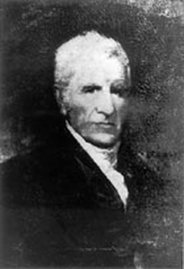 Jacob Mordecai.
Jacob Mordecai. Photo courtesy of Southern History Collection, UNC - Chapel Hill
The Civil War
Despite their articulation of the ideas of liberty and natural rights, Richmond Jews took part in America’s great contradiction, slavery. During the antebellum period, a majority of Richmond Jews owned slaves, mirroring the rate of slave ownership among all whites in the city. As early as 1820, the average Jewish household owned three slaves. Jacob Mordecai, who was perhaps the leading scholar of Judaism in the city but also a plantation owner, had the most. Mordecai was an exception as most Jewish slave owners did not own plantations, but used their slaves as house servants. Jewish merchants did not generally trade in slaves, though five Jewish slave traders lived in Richmond in 1860. Although several Jews freed their slaves in their wills, Richmond Jews were as supportive of slavery as other whites in the city.
The same was true for their support of the Confederacy. Since Richmond was the capital of the Confederate government, the city was swept up in the South’s cause to protect slavery. Rev. Michelbacher of Beth Ahabah was a staunch supporter of secession and the South, and during one wartime service prayed “that the Almighty may…drive away from our land the Northern armies that now disturb our tranquility.” Beth Ahabah’s school building was used as a military hospital, while Beth Shalome’s board voted to invest much of its money in Confederate bonds in 1863, when the war was beginning to turn against the South. Many Jewish women in Richmond served as nurses at the over 15 military hospitals in the city.
Despite their articulation of the ideas of liberty and natural rights, Richmond Jews took part in America’s great contradiction, slavery. During the antebellum period, a majority of Richmond Jews owned slaves, mirroring the rate of slave ownership among all whites in the city. As early as 1820, the average Jewish household owned three slaves. Jacob Mordecai, who was perhaps the leading scholar of Judaism in the city but also a plantation owner, had the most. Mordecai was an exception as most Jewish slave owners did not own plantations, but used their slaves as house servants. Jewish merchants did not generally trade in slaves, though five Jewish slave traders lived in Richmond in 1860. Although several Jews freed their slaves in their wills, Richmond Jews were as supportive of slavery as other whites in the city.
The same was true for their support of the Confederacy. Since Richmond was the capital of the Confederate government, the city was swept up in the South’s cause to protect slavery. Rev. Michelbacher of Beth Ahabah was a staunch supporter of secession and the South, and during one wartime service prayed “that the Almighty may…drive away from our land the Northern armies that now disturb our tranquility.” Beth Ahabah’s school building was used as a military hospital, while Beth Shalome’s board voted to invest much of its money in Confederate bonds in 1863, when the war was beginning to turn against the South. Many Jewish women in Richmond served as nurses at the over 15 military hospitals in the city.
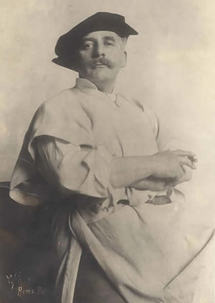 Confederate veteran & sculptor Moses Jacob Ezekiel
Confederate veteran & sculptor Moses Jacob Ezekiel
Over 100 Richmond Jews fought for the South, most in the Richmond Grays or Light Infantry Blues. All six of Myer Angle’s sons fought for the Confederacy. Moses Jacob Ezekiel, the first Jew to attend the Virginia Military Institute, also fought for the South. After the war, General Robert E. Lee encouraged him to pursue his talent as a sculptor. Ezekiel became a renowned artist and was later commissioned to produce the Confederate Memorial at Arlington National Cemetery. A special section of Richmond’s Hebrew Cemetery was created for Jewish Confederate soldiers from across the South who died during the war. For almost a century, the Hebrew Ladies Memorial Association would decorate the 31 graves each year in the only Jewish military cemetery in the United States.
While the Civil War gave Richmond Jews an opportunity to show their loyalty to Virginia and the South, it also gave rise to anti-Semitic accusations of Jewish profiteering and hindrance of the war effort. A Richmond magazine, Southern Punch, often singled Jews out, writing, “the dirty greasy Jew pedlar” who could be seen “bowing and cringing even to negro servants” before the war, “now struts by with the air of a millionaire.” As the Southern war effort faltered, Jews became scapegoats as some members of the Confederate congress in Richmond attacked them as disloyal profiteers. On October 18, 1863, Beth Ahabah held a meeting to discuss a response to the rise of anti-Semitism after the Southern losses at Vicksburg and Gettysburg. The members agreed to find ways “to vindicate our character as Jews and good citizens which has been repeatedly and grossly assailed in public prints.” A few months later, the Richmond Jewish community donated $2000 to help care for sick and wounded soldiers.
While the Civil War gave Richmond Jews an opportunity to show their loyalty to Virginia and the South, it also gave rise to anti-Semitic accusations of Jewish profiteering and hindrance of the war effort. A Richmond magazine, Southern Punch, often singled Jews out, writing, “the dirty greasy Jew pedlar” who could be seen “bowing and cringing even to negro servants” before the war, “now struts by with the air of a millionaire.” As the Southern war effort faltered, Jews became scapegoats as some members of the Confederate congress in Richmond attacked them as disloyal profiteers. On October 18, 1863, Beth Ahabah held a meeting to discuss a response to the rise of anti-Semitism after the Southern losses at Vicksburg and Gettysburg. The members agreed to find ways “to vindicate our character as Jews and good citizens which has been repeatedly and grossly assailed in public prints.” A few months later, the Richmond Jewish community donated $2000 to help care for sick and wounded soldiers.
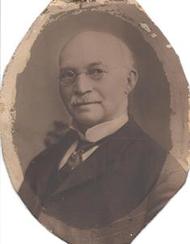 Philip Whitlock
Philip Whitlock
After the Civil War
Although Richmond was destroyed economically after the war, the city quickly rebounded thanks to the growing popularity of cigars and cigarettes. The tobacco industry, along with iron and flour mills, led Richmond’s economy out of the ashes of war. By 1880, the city had 60 tobacco companies. Several Richmond Jews played a part in the city’s resurgence. After the war, Philip Whitlock opened a tobacco manufacturing company that made cheroots, or cheap cigars; he sold the business to the American Tobacco Company in 1891. Charles Millhiser also had a cheroot manufacturing company. Samuel Binswanger started a glass company in 1870 which eventually grew into a national chain. Gustavus Myers and Edward Cohen opened the Merchants and Mechanics Bank in 1867. Known informally as the Jewish Bank, it merged with another local bank in 1910.
The years after the Civil War were a time of turmoil and growth for the Richmond Jewish community, which numbered about 1,000 people in 1877. Not long after the war ended, a group of 30 Jews left Beth Ahabah to establish Beth Israel (House of Israel). The breakaway group wanted a more Reform service and quickly adopted Isaac Mayer Wise’s Minhag America prayer book. By 1866, Beth Israel had bought a building and hired A.L. Mayer as their rabbi. Isaac Mayer Wise officiated at the temple dedication that year. After this quick start, Beth Israel soon languished, especially after their building was commandeered by the city council after city hall had been condemned. Unable to find a new location, Beth Israel’s members rejoined Beth Ahabah in 1871.
Although Richmond was destroyed economically after the war, the city quickly rebounded thanks to the growing popularity of cigars and cigarettes. The tobacco industry, along with iron and flour mills, led Richmond’s economy out of the ashes of war. By 1880, the city had 60 tobacco companies. Several Richmond Jews played a part in the city’s resurgence. After the war, Philip Whitlock opened a tobacco manufacturing company that made cheroots, or cheap cigars; he sold the business to the American Tobacco Company in 1891. Charles Millhiser also had a cheroot manufacturing company. Samuel Binswanger started a glass company in 1870 which eventually grew into a national chain. Gustavus Myers and Edward Cohen opened the Merchants and Mechanics Bank in 1867. Known informally as the Jewish Bank, it merged with another local bank in 1910.
The years after the Civil War were a time of turmoil and growth for the Richmond Jewish community, which numbered about 1,000 people in 1877. Not long after the war ended, a group of 30 Jews left Beth Ahabah to establish Beth Israel (House of Israel). The breakaway group wanted a more Reform service and quickly adopted Isaac Mayer Wise’s Minhag America prayer book. By 1866, Beth Israel had bought a building and hired A.L. Mayer as their rabbi. Isaac Mayer Wise officiated at the temple dedication that year. After this quick start, Beth Israel soon languished, especially after their building was commandeered by the city council after city hall had been condemned. Unable to find a new location, Beth Israel’s members rejoined Beth Ahabah in 1871.
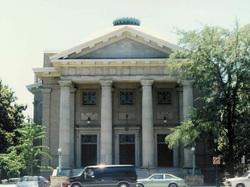 Beth Ahabah's 1904 temple.
Beth Ahabah's 1904 temple. Photo courtesy of Julian Preisler
This merger was aided by Beth Ahabah’s gradual movement toward Reform Judaism. In 1867, the congregation hired Rabbi Judah Wechsler, who gave sermons in German, though Rev. Michelbacher continued to chant the services in Hebrew. That same year, Beth Ahabah instituted mixed-gender seating and a choir, though they still employed a shochet (kosher butcher) and required board members to observe the Sabbath. In 1875, Beth Ahabah joined the newly created Union of American Hebrew Congregations, but adopted the moderate Szold-Jastrow prayer book over the more radical Minhag America. In 1880, with over 100 members, Beth Ahabah dedicated a new, larger synagogue. The congregation’s transition to Reform Judaism was completed with the hiring of Edward Calisch as rabbi in 1891. Calisch, who had been the twelfth rabbi ordained by Hebrew Union College, brought classical Reform to Beth Ahabah. He called for the banning of head coverings and brought in his own prayer book in which he had omitted most of the Hebrew prayers. Rabbi Calisch, who led Beth Ahabah for the next 54 years, became the recognized spokesman for Richmond Jews in dealings with the larger community. A big proponent of interfaith cooperation, Rabbi Calisch often spoke at area churches about Judaism. Beth Ahabah grew under Calisch’s leadership, increasing from 100 members when the rabbi started to 507 when he eventually retired in 1945. In 1904, the congregation moved uptown to a new neo-classical synagogue on Franklin and Ryland Streets, which Beth Ahabah still uses today.
While Beth Ahabah thrived after the Civil War, Beth Shalome struggled as the descendants of the congregation’s founders married non-Jews or members of Beth Ahabah. In 1867, the city’s oldest congregation discussed merging with Keneseth Israel, its youngest. The talks fell through when Keneseth Israel refused to accept the Sephardic pronunciation of the Hebrew prayers. Beth Shalome’s last paid chazzan, Isaac Pereira Mendes, left in 1877 after the board refused to give him a raise due to tight finances. Beth Shalome continued on with lay-led services. Although they had 70 members at the time, Beth Shalome began to discuss merging with Beth Ahabah, though they could not agree on ritual matters. In 1891, Beth Shalome sold their synagogue to the Sir Moses Montefiore Congregation, which had recently been formed by newly arrived immigrants. Finally, in 1898, Beth Shalome dissolved, merging with the much larger Beth Ahabah.
Although Beth Shalome had disbanded, Orthodox Judaism was still alive and well in Richmond. Keneseth Israel had 60 members in 1877, but soon grew with the arrival of new immigrants from Eastern Europe. In 1908 it built a new synagogue in the east end neighborhood where most of the recent Jewish immigrants lived. Reflecting their dedication to Orthodox tradition, the new shul had a mikvah (ritual bath) and a separate balcony for women. Rabbi Calisch of Beth Ahabah gave an address and the closing prayer during the synagogue dedication, reflecting the warm relations between Beth Ahabah and Keneseth Israel. Newly arriving immigrants from Eastern Europe created the Sir Moses Montefiore Congregation in 1886. After meeting in a rented building on Main Street in its early years, the congregation bought Beth Shalome’s synagogue in 1891. In 1905, they purchased another old synagogue; this time it was Beth Ahabah’s former building. Beth Ahabah’s president, Julius Straus, and Rabbi Edward Calisch took part in the dedication ceremony. Over the years, Montefiore drifted away from strict Orthodoxy, instituting mixed-gender seating though they continued to hold daily minyans.
While Beth Ahabah thrived after the Civil War, Beth Shalome struggled as the descendants of the congregation’s founders married non-Jews or members of Beth Ahabah. In 1867, the city’s oldest congregation discussed merging with Keneseth Israel, its youngest. The talks fell through when Keneseth Israel refused to accept the Sephardic pronunciation of the Hebrew prayers. Beth Shalome’s last paid chazzan, Isaac Pereira Mendes, left in 1877 after the board refused to give him a raise due to tight finances. Beth Shalome continued on with lay-led services. Although they had 70 members at the time, Beth Shalome began to discuss merging with Beth Ahabah, though they could not agree on ritual matters. In 1891, Beth Shalome sold their synagogue to the Sir Moses Montefiore Congregation, which had recently been formed by newly arrived immigrants. Finally, in 1898, Beth Shalome dissolved, merging with the much larger Beth Ahabah.
Although Beth Shalome had disbanded, Orthodox Judaism was still alive and well in Richmond. Keneseth Israel had 60 members in 1877, but soon grew with the arrival of new immigrants from Eastern Europe. In 1908 it built a new synagogue in the east end neighborhood where most of the recent Jewish immigrants lived. Reflecting their dedication to Orthodox tradition, the new shul had a mikvah (ritual bath) and a separate balcony for women. Rabbi Calisch of Beth Ahabah gave an address and the closing prayer during the synagogue dedication, reflecting the warm relations between Beth Ahabah and Keneseth Israel. Newly arriving immigrants from Eastern Europe created the Sir Moses Montefiore Congregation in 1886. After meeting in a rented building on Main Street in its early years, the congregation bought Beth Shalome’s synagogue in 1891. In 1905, they purchased another old synagogue; this time it was Beth Ahabah’s former building. Beth Ahabah’s president, Julius Straus, and Rabbi Edward Calisch took part in the dedication ceremony. Over the years, Montefiore drifted away from strict Orthodoxy, instituting mixed-gender seating though they continued to hold daily minyans.
The Community Grows
With this new wave of immigration, Richmond’s Jewish community grew to 5,300 people in 1930. Richmond Jews continued to concentrate in retail trade. A 1909 census of the Jewish community found 287 retail merchants, 15 wholesale business owners, 25 manufacturers, and 11 tailors. Several prominent Jewish businessmen served on local bank boards. In addition to business, Richmond Jews made their mark on the medical profession. Richmond had several Jewish doctors in the early 20th century. Dr. Henry Levy spent over 20 years as a professor of medicine at the Medical College of Virginia while Ernest Levy served as Richmond’s chief medical officer for 11 years. Rosa Zimmern Van Vort was the superintendent of nurses at the medical college and organized the Virginia State League of Nursing in 1922. Harry Bear served as dean of the medical college’s School of Dentistry from 1929 to 1950. Harry Lyons followed him in the position, serving almost 20 years.
With this new wave of immigration, Richmond’s Jewish community grew to 5,300 people in 1930. Richmond Jews continued to concentrate in retail trade. A 1909 census of the Jewish community found 287 retail merchants, 15 wholesale business owners, 25 manufacturers, and 11 tailors. Several prominent Jewish businessmen served on local bank boards. In addition to business, Richmond Jews made their mark on the medical profession. Richmond had several Jewish doctors in the early 20th century. Dr. Henry Levy spent over 20 years as a professor of medicine at the Medical College of Virginia while Ernest Levy served as Richmond’s chief medical officer for 11 years. Rosa Zimmern Van Vort was the superintendent of nurses at the medical college and organized the Virginia State League of Nursing in 1922. Harry Bear served as dean of the medical college’s School of Dentistry from 1929 to 1950. Harry Lyons followed him in the position, serving almost 20 years.
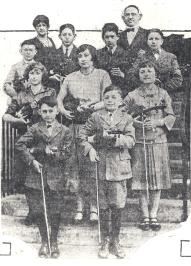 The Neighborhood House youth orchestra, 1925.
The Neighborhood House youth orchestra, 1925.
Charitable Activities
The members of the more established Beth Ahabah congregation worked to help Jewish newcomers assimilate. In 1905, a group of women, most of whom were Beth Ahabah members, established a Richmond chapter of the National Council of Jewish Women. Rabbi Calisch’s wife Gisella was its first president. In 1912, the NCJW chapter opened Neighborhood House in Richmond’s east end to help these immigrants adjust to life in America. A classic settlement house, Neighborhood House offered classes in English and American culture as well as various recreational programs. The building, located at 19th and Broad Streets, had a gym and sponsored a basketball team as well as youth orchestra. The Neighborhood House, which became a community center for the Jewish population of the east end, also held Friday night services and had a Sunday school. The NCJW ran the Neighborhood House until they closed it in 1945.
While the more assimilated part of the Jewish community worked to help the newcomers, these immigrants also established several organizations to help themselves. In 1921, members of Sir Moses Montefiore founded the Hebrew Sick Aid Society. Jennie Scher, its longtime president, was also the head of the Ladies Hebrew Aid Society, which raised money for needy families in the Jewish community. The members of Montefiore also founded a Hebrew Free Loan Society to help aspiring businessmen. In 1945, Richmond Jews, led by Issac Seldes, founded the Beth Sholom Home, and in 1946 bought a house to use as a home for the Jewish elderly. The home served kosher food and offered Orthodox services. In 1957, it built a larger facility in the west end of Richmond. Though it started as a resource for Richmond’s Orthodox Jews, the Beth Sholom Home now serves Jews from across the community.
The members of the more established Beth Ahabah congregation worked to help Jewish newcomers assimilate. In 1905, a group of women, most of whom were Beth Ahabah members, established a Richmond chapter of the National Council of Jewish Women. Rabbi Calisch’s wife Gisella was its first president. In 1912, the NCJW chapter opened Neighborhood House in Richmond’s east end to help these immigrants adjust to life in America. A classic settlement house, Neighborhood House offered classes in English and American culture as well as various recreational programs. The building, located at 19th and Broad Streets, had a gym and sponsored a basketball team as well as youth orchestra. The Neighborhood House, which became a community center for the Jewish population of the east end, also held Friday night services and had a Sunday school. The NCJW ran the Neighborhood House until they closed it in 1945.
While the more assimilated part of the Jewish community worked to help the newcomers, these immigrants also established several organizations to help themselves. In 1921, members of Sir Moses Montefiore founded the Hebrew Sick Aid Society. Jennie Scher, its longtime president, was also the head of the Ladies Hebrew Aid Society, which raised money for needy families in the Jewish community. The members of Montefiore also founded a Hebrew Free Loan Society to help aspiring businessmen. In 1945, Richmond Jews, led by Issac Seldes, founded the Beth Sholom Home, and in 1946 bought a house to use as a home for the Jewish elderly. The home served kosher food and offered Orthodox services. In 1957, it built a larger facility in the west end of Richmond. Though it started as a resource for Richmond’s Orthodox Jews, the Beth Sholom Home now serves Jews from across the community.
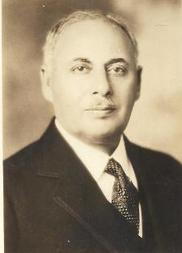 Rabbi Edward Calisch
Rabbi Edward Calisch
Richmond Jews were also concerned about their co-religionists around the world. In 1900, members of the Montefiore Congregation established Richmond’s first Zionist organization. A Hadassah chapter was founded in 1922, while a branch of the labor Zionist Farband was also created in Richmond. Rabbi Calisch and many of the members of Beth Ahabah opposed the notion of a Jewish homeland in Palestine, like many other Reform Jews around the country. Yet Rabbi Calisch and his congregants did not turn their backs on the plight of Jews in Russia. Richmond Jews held several events to call attention and raise money for Jews in Eastern Europe. After the brutal Kishinev pogrom in Russia in 1903, Jews in Richmond held a mass protest and relief meeting at the Bijou Theater which drew over 1,000 people, including the governor, the mayor, and several Christian ministers. After another wave of anti-Jewish violence in Russia in 1905, a similar mass meeting was held, chaired by Rabbi Calisch.
In 1935, the Richmond Jewish Community Council was established to coordinate local charitable efforts and represent Richmond’s Jews in the larger community. At the time, there were significant social barriers between the “German Jews” of Beth Ahabah and the Eastern European Jews of the city’s Orthodox congregations. In its early years, Beth Ahabah members ran the Community Council, although the community grew more unified after World War II. Later, the Community Council became the Richmond Jewish Federation.
In 1935, the Richmond Jewish Community Council was established to coordinate local charitable efforts and represent Richmond’s Jews in the larger community. At the time, there were significant social barriers between the “German Jews” of Beth Ahabah and the Eastern European Jews of the city’s Orthodox congregations. In its early years, Beth Ahabah members ran the Community Council, although the community grew more unified after World War II. Later, the Community Council became the Richmond Jewish Federation.
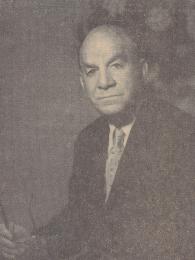 William Thalhimer
William Thalhimer
The 1930s and 1940s
The organized Jewish community faced a serious challenge with the rise of Nazi Germany. Several Richmond Jews worked to bring over and settle Jewish refugees. In all, 328 Jewish refugees settled in Richmond between 1934 and 1943. Most notable were the efforts of William Thalhimer, scion of the prominent department store family, who developed a plan to settle Jewish refugees in Virginia. He hired Ernest Gunzberg to run the program, and convinced other prominent Richmond Jews to offer affidavits and money to help bring over Jewish refugees from Europe. He and his colleagues worked to find them jobs and places to live in various Virginia cities. Thalhimer also had the idea to settle a group of German Jewish teenagers on a Virginia farm an hour outside of Richmond. The plan was for them to raise chickens and grow fruit. By 1940, 34 Jewish children had settled at the Hyde Farmlands Academy. Yet the farm faltered in 1941 due to a lack of funding and manpower to operate it properly. As a result, the farm was sold and the refugees were placed in jobs in other states. Although Thalhimer’s agricultural colony plan was a failure, his efforts to rescue European Jews saved the lives of hundreds.
By 1930, Richmond still had three Jewish congregations. While two of these were Orthodox, the Reform Beth Ahabah was the largest, with 439 families, more than Keneseth Israel and Moses Montefiore combined. Soon after, two new congregations were founded. In 1930, a small group of Orthodox Jews founded Etz Chaim (Tree of Life). By 1939, the congregation had grown to 75 members and had a full-time rabbi. In 1931 a group of members from Keneseth Israel and Montefiore, desiring an English-speaking rabbi and some reforms of strict Orthodoxy, established the Conservative congregation Beth-El (House of God). The founders were largely immigrants who had been in America for many years and wanted a rabbi who could interact with the larger community. Beth-El held its first High Holiday services at the Scottish Rite Temple and soon after leased space in Colombo Hall. In 1935 they hired Morris Frank as their first full-time rabbi. In 1938 the congregation, which had 100 members, bought a former church to use as a synagogue. With its new building, Beth-El entered a period of tremendous growth. By 1942, Beth-El had 300 members and was the second largest Jewish congregation in the city. They began building an expansion to their synagogue, which was not completed until 1949. Rabbi Nathan Kollin replaced Frank in 1941; that same year, they hired Cantor Morris Okun, who served Beth-El until 1985.
The organized Jewish community faced a serious challenge with the rise of Nazi Germany. Several Richmond Jews worked to bring over and settle Jewish refugees. In all, 328 Jewish refugees settled in Richmond between 1934 and 1943. Most notable were the efforts of William Thalhimer, scion of the prominent department store family, who developed a plan to settle Jewish refugees in Virginia. He hired Ernest Gunzberg to run the program, and convinced other prominent Richmond Jews to offer affidavits and money to help bring over Jewish refugees from Europe. He and his colleagues worked to find them jobs and places to live in various Virginia cities. Thalhimer also had the idea to settle a group of German Jewish teenagers on a Virginia farm an hour outside of Richmond. The plan was for them to raise chickens and grow fruit. By 1940, 34 Jewish children had settled at the Hyde Farmlands Academy. Yet the farm faltered in 1941 due to a lack of funding and manpower to operate it properly. As a result, the farm was sold and the refugees were placed in jobs in other states. Although Thalhimer’s agricultural colony plan was a failure, his efforts to rescue European Jews saved the lives of hundreds.
By 1930, Richmond still had three Jewish congregations. While two of these were Orthodox, the Reform Beth Ahabah was the largest, with 439 families, more than Keneseth Israel and Moses Montefiore combined. Soon after, two new congregations were founded. In 1930, a small group of Orthodox Jews founded Etz Chaim (Tree of Life). By 1939, the congregation had grown to 75 members and had a full-time rabbi. In 1931 a group of members from Keneseth Israel and Montefiore, desiring an English-speaking rabbi and some reforms of strict Orthodoxy, established the Conservative congregation Beth-El (House of God). The founders were largely immigrants who had been in America for many years and wanted a rabbi who could interact with the larger community. Beth-El held its first High Holiday services at the Scottish Rite Temple and soon after leased space in Colombo Hall. In 1935 they hired Morris Frank as their first full-time rabbi. In 1938 the congregation, which had 100 members, bought a former church to use as a synagogue. With its new building, Beth-El entered a period of tremendous growth. By 1942, Beth-El had 300 members and was the second largest Jewish congregation in the city. They began building an expansion to their synagogue, which was not completed until 1949. Rabbi Nathan Kollin replaced Frank in 1941; that same year, they hired Cantor Morris Okun, who served Beth-El until 1985.
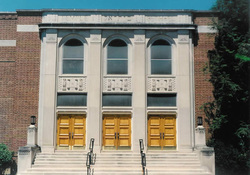 Beth-El.
Beth-El. Photo courtesy of Julian Preisler
The Second Half of the 20th Century
The years after World War II were a period of growth, consolidation, and transition for the Richmond Jewish community. By 1945, 7,500 Jews lived in Richmond. While earlier in the century, Jewish immigrants had settled in the east end, they had begun to move out to the western parts of the city by the 1930s and 1940s. Beth-El was founded in the west end, while the Sir Moses Montefiore Congregation bought a west end Baptist Church in 1947, refurbishing it into a synagogue.
In 1947, Richmond had three Orthodox synagogues; five years later it only had one. In 1948, Etz Chaim merged with Montefiore. Four years later, Montefiore joined with Keneseth Israel to form Keneseth Beth Israel. Rabbi Ephraim Shimoff, who had been Montefiore’s spiritual leader since the early 1940s, became the rabbi of the new congregation. This consolidation made sense as the ethnic distinctions that had once divided the Orthodox community were no longer relevant in the post-war era. Keneseth Beth Israel was modern Orthodox, although it had mixed gender seating. A group desiring stricter Orthodoxy soon broke away to form Beth Torah, which eventually acquired a rabbi, cemetery, mikvah, and religious school. After Beth Torah died out, the remaining members created the Jewish Academy of Richmond, which later became Congregation Kol Emes (Voice of Truth). Keneseth Beth Israel decided to move further west to follow its members in the late 1960s. Their new synagogue on Patterson Avenue incorporated separate seating for women as the congregation moved back toward strict Orthodoxy.
The years after World War II were a period of growth, consolidation, and transition for the Richmond Jewish community. By 1945, 7,500 Jews lived in Richmond. While earlier in the century, Jewish immigrants had settled in the east end, they had begun to move out to the western parts of the city by the 1930s and 1940s. Beth-El was founded in the west end, while the Sir Moses Montefiore Congregation bought a west end Baptist Church in 1947, refurbishing it into a synagogue.
In 1947, Richmond had three Orthodox synagogues; five years later it only had one. In 1948, Etz Chaim merged with Montefiore. Four years later, Montefiore joined with Keneseth Israel to form Keneseth Beth Israel. Rabbi Ephraim Shimoff, who had been Montefiore’s spiritual leader since the early 1940s, became the rabbi of the new congregation. This consolidation made sense as the ethnic distinctions that had once divided the Orthodox community were no longer relevant in the post-war era. Keneseth Beth Israel was modern Orthodox, although it had mixed gender seating. A group desiring stricter Orthodoxy soon broke away to form Beth Torah, which eventually acquired a rabbi, cemetery, mikvah, and religious school. After Beth Torah died out, the remaining members created the Jewish Academy of Richmond, which later became Congregation Kol Emes (Voice of Truth). Keneseth Beth Israel decided to move further west to follow its members in the late 1960s. Their new synagogue on Patterson Avenue incorporated separate seating for women as the congregation moved back toward strict Orthodoxy.
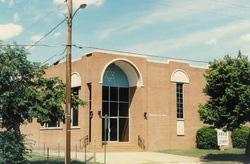 Keneseth Beth Israel.
Keneseth Beth Israel. Photo courtesy of Julian Preisler
Beth-El continued to grow, while also experiencing schisms of its own. In 1957, Beth-El added a new education building to accommodate the baby boom of its members. They enjoyed tremendous stability in their rabbinic leadership, with Rabbi Jacob Milgrom serving from 1951 to 1965, and his successor Myron Berman heading Beth-El until 1993. In 1965, a group desiring a more traditional type of Conservative Judaism founded B’nai Sholom (Brotherhood of Peace). The small congregation lasted 22 years before rejoining Beth-El in 1987. By the 1980s, another group of Beth-El members, who lived in the far west end of Richmond, broke away to form Congregation Or Atid (Light of the Future). These 40 founding families wanted a more egalitarian congregation that was also more conveniently located. Or Atid quickly hired Rabbi Moshe Frankel. Despite these splits, Beth-El became the city’s largest Jewish congregation by the 1970s. By 1987, Beth-El had 850 families. Rabbi Gary Creditor came to Beth-El in 1993 and still led the congregation in 2013.
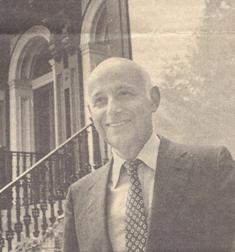 Rabbi Myron Berman
Rabbi Myron Berman
Beth Ahabah was also not immune to splits, although it too experienced tremendous growth in the second half of the 20th century. Rabbi Ariel Goldburg replaced Edward Calisch in 1945, leading Beth Ahabah for the next quarter century. Goldburg gradually led the congregation away from Calisch’s classical Reform as Beth Ahabah grew from 507 families in 1945 to 800 in 1965. In 1958, the congregation built a new education building to accommodate this growth after deciding to remain in their downtown location. In 1972, Jack Spiro became Beth Ahabah’s senior rabbi; he also served as the Director of the Jewish Studies Department at Virginia Commonwealth University. In 1977, Beth Ahabah created a museum and archive to preserve the long history of Jewish life in Richmond. A group unhappy with the ritual and large size of Beth Ahabah broke away in 1972 to establish Or Ami (Light of My People), which offered a more experimental brand of Reform Judaism. During its early years, Or Ami met for services in various buildings and held its religious school at the Jewish Community Center. When Rodof Sholom of Petersburg closed in 1973, they donated their Torah, ark, and pews to the fledgling Richmond congregation. Or Ami hired a rabbi and joined the Union of American Hebrew Congregations in 1973. With 50 founding members, Or Ami grew slowly but steadily, reaching 95 families in 1982 and 145 in 1995.
Jewish organizational life in Richmond also matured during the post-war era. In 1945, the local B’nai B’rith chapter bought an old school building and turned it into a community center. After it burned down in 1948, they bought an old church which they remodeled into what became known as the Richmond Jewish Community Center. In 1959 they built a new facility in the far west end, where the bulk of the city’s Jewish population now lived. The JCC has expanded over the years and continues to offer social, educational, cultural, and athletic activities. In 1955, the Ladies Hebrew Benevolent Society changed its name to Jewish Family Services, offering assistance and counseling for families and children.
Jewish organizational life in Richmond also matured during the post-war era. In 1945, the local B’nai B’rith chapter bought an old school building and turned it into a community center. After it burned down in 1948, they bought an old church which they remodeled into what became known as the Richmond Jewish Community Center. In 1959 they built a new facility in the far west end, where the bulk of the city’s Jewish population now lived. The JCC has expanded over the years and continues to offer social, educational, cultural, and athletic activities. In 1955, the Ladies Hebrew Benevolent Society changed its name to Jewish Family Services, offering assistance and counseling for families and children.
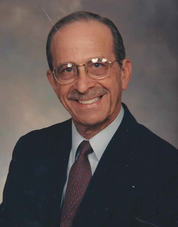 Rabbi Jack Spiro
Rabbi Jack Spiro
Civic Engagement
Throughout their history, Richmond Jews played prominent roles in the larger community, though they did face occasional anti-Semitism. During the first half of the 20th century, Jews were excluded from certain elite neighborhoods and social clubs.
Nevertheless, they were actively involved in local government. Sol Bloomberg served on the city council from 1902 to 1912 while Marx Gunst was elected to city council in 1917, and later served many years on the Board of Aldermen. Morton Thalhimer, a prominent real estate mogul, served as board chairman of Richmond Memorial Hospital and was a founding sponsor of the University of Virginia’s Graduate School of Business. During the turmoil of the civil rights era, Richmond Jews sometimes found themselves in the crossfire. When the Richmond office of the Anti-Defamation League provided information to an NAACP workshop in Charlottesville in 1958, local newspaper editor James J. Kilpatrick wrote an editorial blaming Jewish support for civil rights as the cause of recent anti-Semitism. Richmond Jews were deeply unsettled by the editorial, although no local synagogues or other Jewish institutions suffered any physical attack during this era.
Throughout their history, Richmond Jews played prominent roles in the larger community, though they did face occasional anti-Semitism. During the first half of the 20th century, Jews were excluded from certain elite neighborhoods and social clubs.
Nevertheless, they were actively involved in local government. Sol Bloomberg served on the city council from 1902 to 1912 while Marx Gunst was elected to city council in 1917, and later served many years on the Board of Aldermen. Morton Thalhimer, a prominent real estate mogul, served as board chairman of Richmond Memorial Hospital and was a founding sponsor of the University of Virginia’s Graduate School of Business. During the turmoil of the civil rights era, Richmond Jews sometimes found themselves in the crossfire. When the Richmond office of the Anti-Defamation League provided information to an NAACP workshop in Charlottesville in 1958, local newspaper editor James J. Kilpatrick wrote an editorial blaming Jewish support for civil rights as the cause of recent anti-Semitism. Richmond Jews were deeply unsettled by the editorial, although no local synagogues or other Jewish institutions suffered any physical attack during this era.
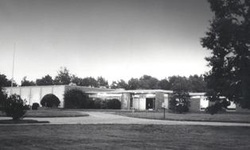 Richmond JCC built in 1959
Richmond JCC built in 1959
The Late 20th Century
By 1983, an estimated 8,000 Jews lived in Richmond, but only 22% of household heads were born in the city; over half were born outside the South. Most came to Richmond for work or business opportunities. Thirty percent were involved in the mercantile industry while over 11% of employed men were doctors and 8% were lawyers. Another population study conducted in 1994, which found many more unaffiliated and intermarried Jews, estimated that 12,000 Jews lived in the Richmond metropolitan area. While only 4% identified as Orthodox, Richmond Jews set up an eruv in the city’s Orthodox neighborhood in 1994. A Chabad House opened in 1977.
By 1983, an estimated 8,000 Jews lived in Richmond, but only 22% of household heads were born in the city; over half were born outside the South. Most came to Richmond for work or business opportunities. Thirty percent were involved in the mercantile industry while over 11% of employed men were doctors and 8% were lawyers. Another population study conducted in 1994, which found many more unaffiliated and intermarried Jews, estimated that 12,000 Jews lived in the Richmond metropolitan area. While only 4% identified as Orthodox, Richmond Jews set up an eruv in the city’s Orthodox neighborhood in 1994. A Chabad House opened in 1977.
The Jewish Community in Richmond Today
In 2013, the Richmond Jewish community held steady at an estimated 10,000 Jews. Despite its relatively small size, the Richmond Jewish community supports several institutions, including seven different congregations, the Rudlin Torah Academy day school, two Orthodox high schools, a Jewish Federation, a JCC, the Beth Sholom retirement home, Jewish Family Services, as well as the Virginia Holocaust Museum and the Beth Ahabah Museum and Archives. Richmond Jews remain active in civic life. Most notably, Eric Cantor represented the city in the U.S. Congress from 2000 to 2014, becoming the House Majority Leader in 2011.
For almost 250 years, Jews have found a home in Richmond. While its Jewish community has been surpassed in recent years by the upstart Jewish communities of northern Virginia, Richmond will remain a center of Southern Jewish life and history.
For almost 250 years, Jews have found a home in Richmond. While its Jewish community has been surpassed in recent years by the upstart Jewish communities of northern Virginia, Richmond will remain a center of Southern Jewish life and history.
Sources
Berman, Myron. Richmond’s Jewry: Shabbat in Shockoe, 1769-1976. Charlottesville: The University Press of Virginia, 1979.
